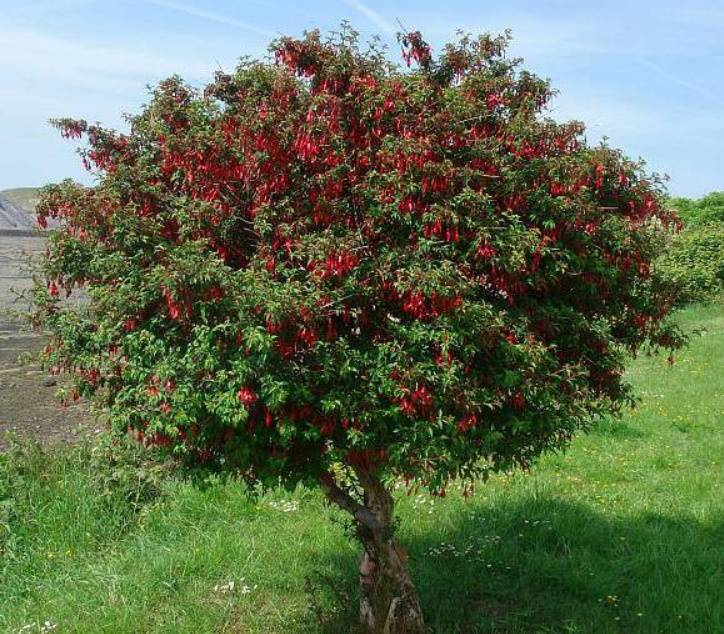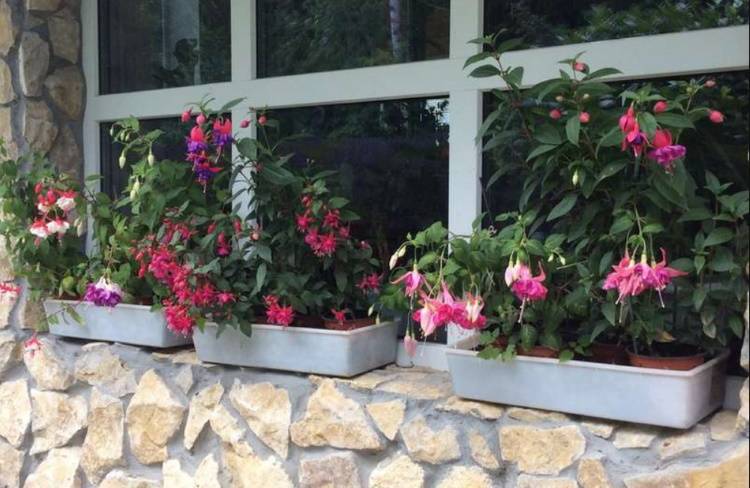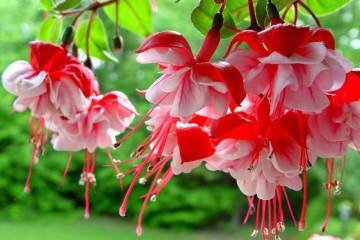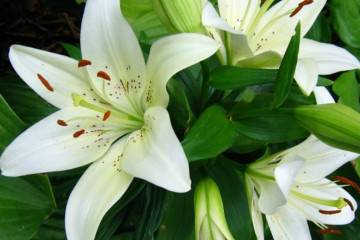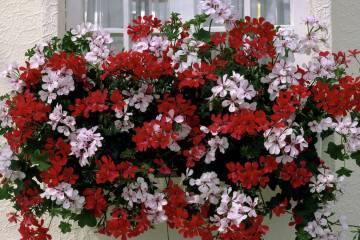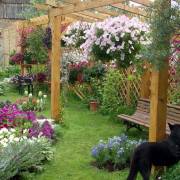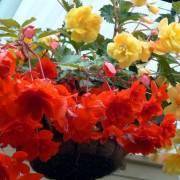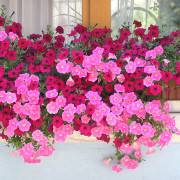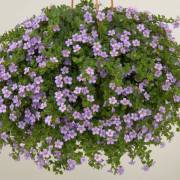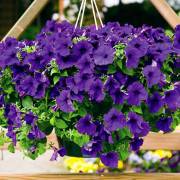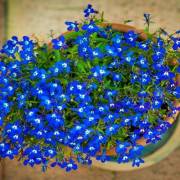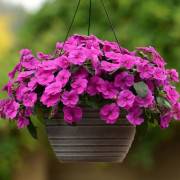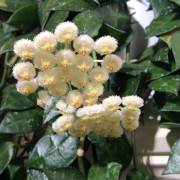Fuchsia in a pot on the street - how to care and in which pot to plant
Content:
In the wild, fuchsia is a perennial evergreen shrub or a small tree growing on the nutrient soils of forest roadsides, moist mountain crevices. The birthplace of flowers, called Fuchsia (lat.) In botany, are Latin America, New Zealand. In their modern form, in unprotected soil, fuchsias are grown in countries characterized by mild winters and cool summers. In temperate climates, it is unrealistic to grow these flowers in the open air, but fuchsia growing in a pot in the garden is quite possible.
Fuchsia in a flowerpot on the street
Fuchsias for their beautiful flowering, delicate petals, elegant stamens are sometimes compared to ballerinas dressed in openwork skirts. Growing such beauty in faceless monochromatic flower pots is not very aesthetically pleasing, it would seem better to use colorful pots. Fuchsia in a flowerpot looks very presentable, but it can die if the soil is poured directly into the flowerpot, because there are no drainage holes in these decorative vessels.
In cold regions, all Fuchsia species are planted and grown in various containers with holes for draining the water, and then, if desired or necessary, these containers are placed inside the planter.
The need to place a pot with fuchsia outside in a flowerpot arises if hot weather sets in. For Fuchsia, overheating means death, therefore, in order to protect the plant's root system, the main flower grower is placed in a large planter. Heat-insulating materials are poured into the free space between the walls to create a protective layer. It can be expanded clay, sand, ordinary garden soil.
Fuchsia in hanging pots
Breeders based on several dozen wild species of Fuchsia have created about 8 thousand varieties of plants, which are divided into 5 main groups:
- one-flowered, their inflorescences consist of 4 petals,
- semi-double with 5 or 7 petals;
- terry, they have 8 or more petals;
- three-leafed with inflorescences in the form of long tubes;
- lying with creeping shoots.
Among these groups, many varieties are ampelous, ampel-bush, it is these types of fuchsias that are grown in hanging pots.
For home breeding, hybrid Fuchsia species are most often used. Among them:
- Holly's Beauty - a plant with large inflorescences of white sepals with a serrated lilac terry skirt;
- Bella Rosella has large oblong buds of pink sepals and a lilac skirt;
- Bicentennial initially blooms with pale orange double inflorescences, eventually acquiring a bright orange hue. Flowers are decorated with a red skirt.
In order for ampelous fuchsias in a hanging pot to have a neat appearance and to bloom actively, they must be placed in a place protected from gusts of wind and direct rays of the sun. Many gardeners hang them on trees, in the shade of their branches, but at the same time they are very firmly attached to the trunks.
How to care for fuchsia in a pot
In temperate climates, the frost-insensitive Fuchsia Magellanica is used for outdoor cultivation in gardens and parks. The plant is pruned for the winter and covered with a thick layer of mulch. In the spring, the shelter is removed, new shoots appear, on which raspberry-purple inflorescences bloom by August. The rest of the Fuchsia species in winter in frost are kept as home potted crops.
Caring for fuchsia at home in cold and warm seasons should provide plants with an air humidity of at least 80%, a temperature not higher than 20 ° C and not lower than 0 ° C, protection from sunburn and overheating at midday, timely watering, feeding, pruning , peace in the winter.
With the onset of warming, fuchsias can be:
- left at home for growing on windowsills or balconies:
- placed in pots, including hanging ones, and brought out in partial shade to the street;
- together with the pots, they were dug into the ground in the open air under cover from the scorching sun.
Thus, the flowers actually grow in pots, but they are either in dry air in an apartment, or in fresh outdoor air.
The advantages of outdoor cultivation of fuchsias in pots compared to placement in hanging pots are obvious: the plants do not suffer from gusts of wind, their roots do not overheat, and it is easier to water them.
Growing fuchsia in a pot
Florists start growing fuchsias not with flower pots, but with small 50 ml of plastic cups with holes in the bottom for water drainage, in which the earthen ball and the volume of the root system are clearly visible. Fuchsias are transplanted from plastic cups, without damaging the roots, into small plastic thin-walled pots or 100 ml cups.
Fuchsia cuttings are also planted in small cups for rooting. Usually cut fuchsia stems up to 10-15 cm long are left in water for root germination. Fuchsia cuttings, even without treatment with root stimulants and soil, form roots very quickly (in 2-3 weeks). Transplanting cuttings into the ground can be started when 2-3 roots are formed.
Fuchsia cuttings with root shoots are planted in pre-prepared loose soil. It shouldn't be wet. Dry soil is poured onto the bottom of the glass, a handle is placed on it, the roots are straightened, dry soil is poured on top again. The roots must be completely buried in the ground. Only after that, using a sprayer, water is poured into the glass.
The choice of soil substrate
All Fuchsia species grow in slightly acidic soils. The best option for rooting a cuttings or transplanting a plant would be a ready-made mixture from a flower shop, which includes peat, coconut fibers and vermiculite.
If it is possible to prepare the substrate yourself, use a mixture of rotted manure, high peat, black soil, sand in a ratio of 2: 1: 1: 0.5. Vermiculite and crushed coniferous sawdust are added to the substrate.
What kind of pot is needed for fuchsia
For Fuchsia of different ages, pots of different sizes are used. You can determine which pot is needed for a flower by the state of its root system. A lump of earth completely entwined with roots suggests that the plant can be planted in a larger flower garden.
For normal development, fuchsias must grow in clay, earthenware containers with drainage holes or in plastic, but inserted into a thick-walled planter. Depending on the type of flower, the shape of the pot is chosen. Sprawling bushy forms are grown in wide flower beds. For ampelous plants, high capacities are selected.
Planting fuchsia in a pot
A plant that can already be planted in a pot must be carefully removed from the glass. A layer of substrate is poured at the bottom of the flower grower, then a flower with an intact earthen lump is placed and soil is poured around it. The root collar of fuchsia is buried in the soil.
To create beautiful flower arrangements from different Fuchsia species, several plants are sometimes planted in one pot. But this experiment is not always successful, especially if ampelous and bushy types of flowers are planted in one container. They begin to shade each other, their roots intertwine. With the next transplant, the plants cannot be separated.
If Fuchsia, as their root system grows, is transplanted into larger flower beds, from them, with sufficient watering and feeding, plants several meters high can grow. Thus, a small fuchsia is a flower in a pot, which, if properly grown, can develop into a flower tree over the years.
Choosing a location and watering mode
For growing Fuchsia outdoors, choose shaded cool areas of the garden. In full shade, plants will not form a sufficient number of buds, and in the sun they will suffer from heat. In the conditions of an apartment in winter, flowers can be placed on covered balconies or loggias. If the air temperature drops below 1 ° C, the plants are brought into the apartment or heaters are connected.
In summer, spring and autumn, plants are watered as the topsoil dries up. During the winter dormant period, watering should be minimal, especially if the flowers are in low temperatures.
It should always be remembered that fuchsias sometimes simply die from overflow, but this should not be allowed. After all, blooming adult fuchsia bushes cause only positive emotions, especially if they grow in beautiful pots or flowerpots.
